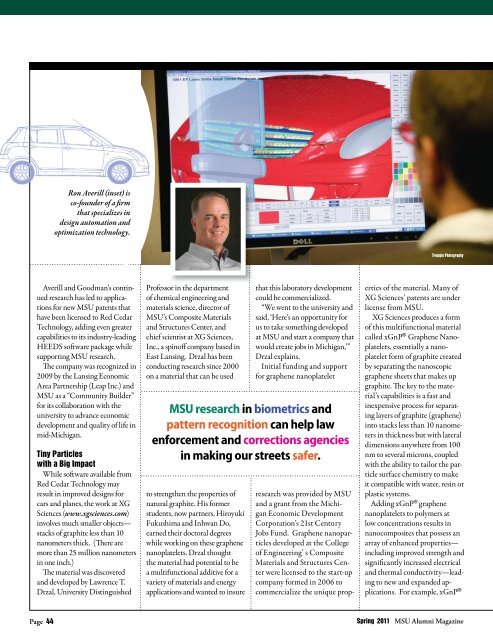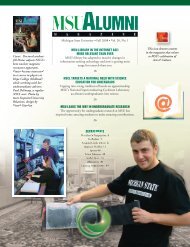Download - MSU Alumni Association - Michigan State University
Download - MSU Alumni Association - Michigan State University
Download - MSU Alumni Association - Michigan State University
Create successful ePaper yourself
Turn your PDF publications into a flip-book with our unique Google optimized e-Paper software.
Ron Averill (inset) is<br />
co-founder of a firm<br />
that specializes in<br />
design automation and<br />
optimization technology.<br />
Trumpie Photography<br />
Averill and Goodman’s continued<br />
research has led to applications<br />
for new <strong>MSU</strong> patents that<br />
have been licensed to Red Cedar<br />
Technology, adding even greater<br />
capabilities to its industry-leading<br />
HEEDS software package while<br />
supporting <strong>MSU</strong> research.<br />
The company was recognized in<br />
2009 by the Lansing Economic<br />
Area Partnership (Leap Inc.) and<br />
<strong>MSU</strong> as a “Community Builder”<br />
for its collaboration with the<br />
university to advance economic<br />
development and quality of life in<br />
mid-<strong>Michigan</strong>.<br />
Tiny Particles<br />
with a Big Impact<br />
While software available from<br />
Red Cedar Technology may<br />
result in improved designs for<br />
cars and planes, the work at XG<br />
Sciences (www.xgsciences.com)<br />
involves much smaller objects—<br />
stacks of graphite less than 10<br />
nanometers thick. (There are<br />
more than 25 million nanometers<br />
in one inch.)<br />
The material was discovered<br />
and developed by Lawrence T.<br />
Drzal, <strong>University</strong> Distinguished<br />
Professor in the department<br />
of chemical engineering and<br />
materials science, director of<br />
<strong>MSU</strong>’s Composite Materials<br />
and Structures Center, and<br />
chief scientist at XG Sciences,<br />
Inc., a spinoff company based in<br />
East Lansing. Drzal has been<br />
conducting research since 2000<br />
on a material that can be used<br />
to strengthen the properties of<br />
natural graphite. His former<br />
students, now partners, Hiroyuki<br />
Fukushima and Inhwan Do,<br />
earned their doctoral degrees<br />
while working on these graphene<br />
nanoplatelets. Drzal thought<br />
the material had potential to be<br />
a multifunctional additive for a<br />
variety of materials and energy<br />
applications and wanted to insure<br />
that this laboratory development<br />
could be commercialized.<br />
“We went to the university and<br />
said, ‘Here’s an opportunity for<br />
us to take something developed<br />
at <strong>MSU</strong> and start a company that<br />
would create jobs in <strong>Michigan</strong>,’”<br />
Drzal explains.<br />
Initial funding and support<br />
for graphene nanoplatelet<br />
<strong>MSU</strong> research in biometrics and<br />
pattern recognition can help law<br />
enforcement and corrections agencies<br />
in making our streets safer.<br />
research was provided by <strong>MSU</strong><br />
and a grant from the <strong>Michigan</strong><br />
Economic Development<br />
Corporation’s 21st Century<br />
Jobs Fund. Graphene nanoparticles<br />
developed at the College<br />
of Engineering’ s Composite<br />
Materials and Structures Center<br />
were licensed to the start-up<br />
company formed in 2006 to<br />
commercialize the unique properties<br />
of the material. Many of<br />
XG Sciences’ patents are under<br />
license from <strong>MSU</strong>.<br />
XG Sciences produces a form<br />
of this multifunctional material<br />
called xGnP ® Graphene Nanoplatelets,<br />
essentially a nanoplatelet<br />
form of graphite created<br />
by separating the nanoscopic<br />
graphene sheets that makes up<br />
graphite. The key to the material’s<br />
capabilities is a fast and<br />
inexpensive process for separating<br />
layers of graphite (graphene)<br />
into stacks less than 10 nanometers<br />
in thickness but with lateral<br />
dimensions anywhere from 100<br />
nm to several microns, coupled<br />
with the ability to tailor the particle<br />
surface chemistry to make<br />
it compatible with water, resin or<br />
plastic systems.<br />
Adding xGnP ® graphene<br />
nanoplatelets to polymers at<br />
low concentrations results in<br />
nanocomposites that possess an<br />
array of enhanced properties—<br />
including improved strength and<br />
significantly increased electrical<br />
and thermal conductivity—leading<br />
to new and expanded applications.<br />
For example, xGnP ®<br />
Page 44<br />
Spring 2011 <strong>MSU</strong> <strong>Alumni</strong> Magazine

















